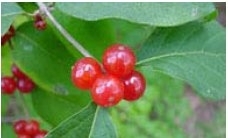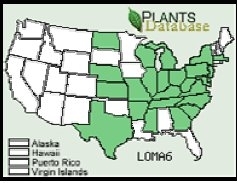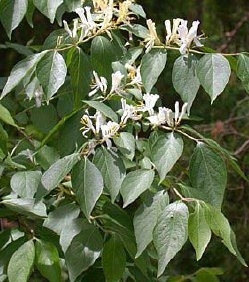Amur Honeysuckle (Biology)
Contents
Amur Honeysuckle
Amur Honeysuckle
Lonicera maackii (Rupr.) Herder
This article was produced by the USDA Forest Service, Forest Health Staff, Newtown Square, PA. WOW 09-05-05. Invasive Plants Website
Native Origin
Native to eastern Asia; introduced into North America in 1896 for use as ornamentals, for wildlife cover and for soil erosion control.
Description
 An erect multi-stemmed erect deciduous shrub with arching branches that grows up to 30 feet tall. The leaves are opposite, simple, ovate, 2 to 3 inches long, green above, paler and slightly fuzzy below. Fragrant flowers are tubular with very thin petals and appear in late spring. They are white changing to yellow and 3/4 to 1 inch in length. Abundant red berries, 1/4 inch in diameter, appear in late summer and often persist throughout winter. The stems are hollow with stringy tan bark. It reproduces both vegetatively and by seeds.
An erect multi-stemmed erect deciduous shrub with arching branches that grows up to 30 feet tall. The leaves are opposite, simple, ovate, 2 to 3 inches long, green above, paler and slightly fuzzy below. Fragrant flowers are tubular with very thin petals and appear in late spring. They are white changing to yellow and 3/4 to 1 inch in length. Abundant red berries, 1/4 inch in diameter, appear in late summer and often persist throughout winter. The stems are hollow with stringy tan bark. It reproduces both vegetatively and by seeds.
Habitat
Amur Honeysuckle can grow in a wide range of soil types. It tolerates wet soils for brief periods of time, such as at the edge of streams and creek banks that occasionally overflow. It can grow in full sun or full shade and can be found in fencerows, thickets, woodlands, roadsides, pastures, old fields, neglected areas and lawns. It is tolerate of all types of pollution, and thrives on neglect, tolerating severe summer droughts and cold winter temperatures with minimal dieback. It readily grows in zones 3 to 8.
Distribution
 It is located throughout the Eastern and Midwestern United States as indicated by the shaded states on the map.
It is located throughout the Eastern and Midwestern United States as indicated by the shaded states on the map.
Ecological Impacts
In forests the plant can adversely affect populations of native members of the community. It can spread rapidly due to the seeds being dispersed by birds and mammals. It can form a dense understory thicket which can restrict native plant growth and tree seedling establishment.
Toxicity
Berries may be mildly poisonous if eaten.
Control and Management
- Manua l- Hand removal of seedlings or small plants may be useful for light infestations. Repeated clipping yearly to prevent dense stands from forming.
- Chemical- Use a systemic herbicide. Thoroughly wet all leaves with glyphosate (e.g., Roundup) as a 2-percent solution in water with a surfactant from August to October. Cut large stems and immediately treat stumps with imazapyr as a 10 percent solution or a glyphosate herbicide as a 20-percent solution. Check label directions for details. Contact your state coop extension for local recommendations.
- Prescribed burning- Initiate prescribed burning prior to the seed dispersal period (late summer to earlyautumn) to minimize reinvasion of treated habitats.
References
- www.dnr.state.oh.us/forestry/Education/ohiotrees/honeysuckle.htm;
- http://enature.com/native_invasives_top.asp,
- www.nps.gov/plants/alien/fact/loni1.htm,
- http://www.cnr.vt.edu/dendro/dendrology/syllabus/factsheet.cfm?ID=268,
- www.duke.edu/~cwcook/trees/loma.html, www.invasive.org/browse/subject.cfm?sub=3040
- http://plants.usda.gov, Nonnative Invasive Plants of Southern Forests p. 78
Editor's Note
- Amur Honeysuckle. U.S. Forest Service

2 Comments
Sidney Draggan wrote: 10-15-2010 04:10:31
Mr. Kulbeth: Thank you for your comment and your note about the USFS Distribution map. I am encouraged that the Encyclopedia is being used (in particular, extending public access to open access, governmental information).
James Kulbeth wrote: 10-14-2010 09:54:27
An amur honeysuckle plant came up from a bird dropped seed (I assume) under one of my old fruit trees. I knew it was a honeysuckle with red berries, and it was an agressive shade tolerant plant. I carefully sprayed it with glyphosate last summer and killed it. I live in Fountain, El Paso County, Colorado. There must be more around as a source of the seed. I am a botanist and natural resources specialist and have found many first sightings of invasive plants in my area. When Liz Galli-Noble from The Center for Invasive Plant Management sent the Amur Honeysuckle notice, I saw that Colorado was not indicated on the distribution map, so I thought I would share the information.